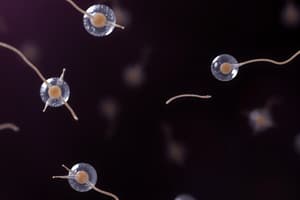Podcast
Questions and Answers
Which of the following accurately describes the relationship between the ovaries and the oviducts?
Which of the following accurately describes the relationship between the ovaries and the oviducts?
- The ovaries produce eggs which travel through the urethra to reach the oviducts.
- The ovaries are directly connected to the oviducts, allowing for seamless egg transfer.
- The ovaries are connected to the uterus, which then connects to the oviducts.
- The ovaries are not directly attached to the oviducts; the oviducts have funnel-shaped openings to receive eggs. (correct)
What is the primary function of the myometrium during pregnancy?
What is the primary function of the myometrium during pregnancy?
- To secrete hormones necessary for fetal development.
- To enable the uterus to expand and contract during pregnancy and childbirth. (correct)
- To facilitate nutrient exchange between mother and fetus.
- To provide a protective barrier against infection.
How does the structure of the cervix contribute to its function during childbirth?
How does the structure of the cervix contribute to its function during childbirth?
- It connects only to the urethra allowing for efficient waste removal during pregnancy.
- It secretes hormones that initiate labor.
- It is a rigid structure that protects the uterus from external trauma.
- It dilates significantly, connecting the uterine cavity and the vaginal cavity to allow the fetus to pass through. (correct)
How do the urethra and vagina's arrangement differ in females compared to males, and what is the functional significance of this difference?
How do the urethra and vagina's arrangement differ in females compared to males, and what is the functional significance of this difference?
What structural adaptations make sperm cells suited for their function?
What structural adaptations make sperm cells suited for their function?
How does the number of eggs produced in a female's lifetime compare to the number of sperm produced in a male's lifetime?
How does the number of eggs produced in a female's lifetime compare to the number of sperm produced in a male's lifetime?
What adaptations are present in the egg cell to aid in fertilization?
What adaptations are present in the egg cell to aid in fertilization?
If a drug were developed to block the production of estrogen in females, what secondary sexual characteristic development would most likely be affected?
If a drug were developed to block the production of estrogen in females, what secondary sexual characteristic development would most likely be affected?
What role do sex hormones play in the physical changes observed during puberty?
What role do sex hormones play in the physical changes observed during puberty?
Given that the formation of female gametes begins before birth, what implication does this have for potential offspring?
Given that the formation of female gametes begins before birth, what implication does this have for potential offspring?
What is the functional significance of the egg's jelly-like layer?
What is the functional significance of the egg's jelly-like layer?
If a male were given medication that drastically reduced his testosterone levels, which of the following would be most likely to occur?
If a male were given medication that drastically reduced his testosterone levels, which of the following would be most likely to occur?
Which statement accurately compares the timing of gamete production in males versus females?
Which statement accurately compares the timing of gamete production in males versus females?
During puberty, an increase in estrogen levels in females leads to which of the following?
During puberty, an increase in estrogen levels in females leads to which of the following?
What is the relationship between puberty and adolescence?
What is the relationship between puberty and adolescence?
Flashcards
Reproduction
Reproduction
The process by which organisms create offspring.
Testes
Testes
Male gonads that produce sperm and testosterone.
Testes outside the body
Testes outside the body
To maintain a lower temperature, optimal for sperm production.
Semen
Semen
Signup and view all the flashcards
Ovaries
Ovaries
Signup and view all the flashcards
Where does the embryo develop?
Where does the embryo develop?
Signup and view all the flashcards
Neckline part at the base of the uterus
Neckline part at the base of the uterus
Signup and view all the flashcards
Puberty and Adolescence
Puberty and Adolescence
Signup and view all the flashcards
When sperm production begins in males
When sperm production begins in males
Signup and view all the flashcards
Secondary Sexual Characteristics
Secondary Sexual Characteristics
Signup and view all the flashcards
Female Reproductive System
Female Reproductive System
Signup and view all the flashcards
Oviduct (Fallopian Tube)
Oviduct (Fallopian Tube)
Signup and view all the flashcards
Endometrium
Endometrium
Signup and view all the flashcards
Egg Cell
Egg Cell
Signup and view all the flashcards
Sperm Cell
Sperm Cell
Signup and view all the flashcards
Study Notes
- Semen comprises sperm and fluids from glands like the seminal vesicles and prostate gland.
- Semen contains fructose for sperm nourishment and has a pH that helps neutralize female reproductive tract acidity.
- The male genital organ, the penis, facilitates the exit of both urine and semen through the urethra.
Female Reproductive System
- It includes two ovaries, two oviducts (fallopian tubes), a uterus, and a vagina.
- Ovaries produce female gametes (eggs/ova) and sex hormones (estrogen/progesterone).
- Oviducts (fallopian tubes) receive eggs from the ovaries and conduct them to the uterus.
- The uterus is where the embryo develops, is normally the size of a clenched fist, and expands during pregnancy.
- The myometrium is the thick, smooth muscle layer of the uterus, and the endometrium is the inner mucous lining.
- The cervix is the neck-like structure at the base of the uterus, connecting the uterine and vaginal cavities.
- The vagina extends from the cervix to the body's exterior, receiving semen and serving as the birth canal.
- In females, the urethra is separate from the reproductive system.
Puberty
- Puberty is the period when humans become sexually mature.
- In males, sperm production begins during puberty and declines with age.
- In females, puberty marks the beginning of the menstrual cycle with the first ovulation.
- Male secondary sexual characteristics include pubic/facial hair, voice deepening, and muscle development.
- Female secondary sexual characteristics include breast development, pubic hair, and pelvis size increase.
- Females typically reach puberty earlier than males.
- Adolescence is the period between childhood and adulthood.
- Sex hormones drive the changes during puberty in both males and females.
- Testosterone increase in males is essential for sperm production and male secondary sexual characteristics.
- Estrogen increase in females triggers the first ovulation and female secondary sexual characteristics.
Male versus Female Gametes
- Sperm production starts at puberty in males, while egg formation in females begins before birth.
- At birth, females have 1-2 million immature eggs; about 400,000 remain by puberty.
- Typically, one ovary releases one mature egg each month via ovulation.
- Millions of sperm cells are in each semen release.
- Sperm and eggs are adapted for their functions and differ structurally.
- An egg cell is large, immotile, possesses a haploid nucleus, and is nutrient-rich.
- A surrounding jelly layer on an egg is important for fertilization.
- After sperm entry, this jelly layer hardens to prevent other sperm from entering.
Studying That Suits You
Use AI to generate personalized quizzes and flashcards to suit your learning preferences.





